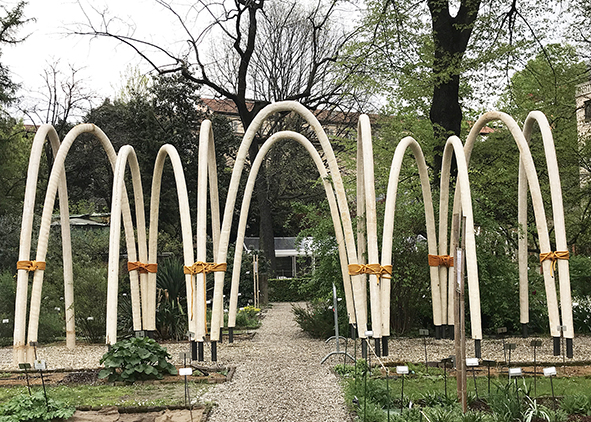BIM Technology and Material Innovation. The Environmental Dimension
DOI:
https://doi.org/10.19229/2464-9309/552019Keywords:
building information modelling, database, environmental compatibility, innovative materials, material load capacityAbstract
The considerations reported in the following paper take inspiration from interdisciplinary research carried out by authors and relative to the application of BIM technology for the management of the building process. In this regard, the research focuses on the role that this computer technology has in the choice and assessment of the use of different materials while considering their performance in the whole life cycle of the building. In particular, the present work summarizes the role that BIM technology has in the control of the environmental dimension of natural matrix innovative building materials. This evaluation is pursued through the processing of a set of criteria able to describe the quality of a given material especially in terms of compatibility.
Downloads
Article Metrics Graph
References
Altamura, P. (2015), Costruire a zero rifiuti – Strategie e strumenti per la prevenzione e l’upcycling dei materiali di scarto in edilizia, FrancoAngeli, Milano.
ARUP (2016), The Circular Economy in the Built Environment. [Online] Available at: www.arup.com/perspectives/publications/research/section/circular-economy-in-the-built-environment [Accessed 26 March 2019].
Beylerian, G. M., Dent, A. H. and Quinn, B. (2007), Ultra Materials – How Materials Innovation is Changing the World, Thames and Hudson, New York.
Casini, M. (2016), Smart Buildings. Advanced Materials and Nanotechnology to Improve Energy-Efficiency and Environmental Performance, Woodhead Publishing.
Chong, H. Y., Lee, C. Y. and Wang, X. (2017), “A mixed review of the adoption of Building Information Modelling (BIM) for sustainability”, in Journal of Cleaner Production, n. 142, pp. 4114-4126.
Chu, M., Matthews, J. and Love, P. E. (2018), “Integrating mobile building information modelling and augmented reality systems: an experimental study”, in Automation in Construction, n. 85, pp. 305-316.
Das, B. B. and Neithalath, N. (eds) (2019), Sustainable Construction and Building Materials, Springer.
Dixit, M. K., Venkatraj, V., Ostadalimakhmalbaf, M., Pariafsai, F. and Lavy, S. (2019), “Integration of facility management and building information modeling (BIM) – A review of key issues and challenges”, in Facilities, vol. 37, issue 7-8, pp. 455-483.
Djuedja, J. F. T., Karray, M. H., Foguem, B. K., Magniont, C. and Abanda, F. H. (2019), “Interoperability Challenges in Building Information Modelling (BIM)”, in Popplewell, K., Thoben, K. D., Knothe, T. and Poler, R. (eds), Enterprise Interoperability VIII. Proceedings of the I-ESA Conferences, vol. 9, Springer, Cham, pp. 275-282.
Jalaei, F., Zoghi, M. and Khoshand, A. (2019), “Life cycle environmental impact assessment to manage and optimize construction waste using Building Information Modeling (BIM)”, in International Journal of Construction Management. [Online] Available at: www.tandfonline.com/doi/abs/10.1080/15623599.2019.1583850 [Accessed 30 March 2019].
Kabisch, N., Bonn, A., Korn, H. and Stadler, J. (eds) (2017), Nature-based Solutions to Climate Change Adaptation in Urban Areas – Linkages Between Science, Policy and Practice, Springer.
Kretzer, M. (2017), Information Materials – Smart Materials for Adaptive Architecture, Springer.
MacArthur, D. E., Zumwinkel, K. and Stuchtey, M. R. (2015), Growth within – a circular economy vision for a competitive Europe. [Online] Available at: www.ellenmacarthurfoundation.org/assets/downloads/publications/ [Accessed 26 March 2019].
Marini, S. and Santangelo, V. (eds) (2013), Nuovi cicli di vita per architetture e infrastrutture della città e del paesaggio, Aracne, Roma.
Matthews, J., Love, P. E., Mewburn, J., Stobaus, C. and Ramanayaka, C. (2018), “Building information modelling in construction: insights from collaboration and change management perspectives”, in Production Planning & Control, vol. 29, issue 3, pp. 202-216.
Mayor of London (2018), London Environment Strategy, Greater London Authority, London.
Mulhall, D., Braungart, M. and Hansen, K. (2019), Creating buildings with positive impacts, Technische Universität München, München.
Osservatorio Recycle (2017), L’economia circolare nel settore delle costruzioni. [Online] Available at: www.legambiente.it/sites/default/files/docs/rapporto_recycle_2017.pdf [Accessed 28 March 2019].
Saieg, P., Sotelino, E. D., Nascimento, D. and Caiado, R. G. G. (2018), “Interactions of building information modeling, lean and sustainability on the architectural, engineering and construction industry: a systematic review”, in Journal of Cleaner Production, n. 174, pp. 788-806.
Sennett, R. (2008), L’uomo artigiano, Feltrinelli, Milano.
Starace, F. and Realacci, E. (2018), 100 Italian circular economy stories. [Online] Available at: www.symbola.net/html/article/100italiancirculareconomy [Accessed 28 March 2019].
Tang, S., Shelden, D. R., Eastman, C. M., Pishdad-Bozorgi, P. and Gao, X. (2019), “A review of building information modeling (BIM) and the internet of things (IoT) devices integration: Present status and future trends”, in Automation in Construction, n. 101, pp. 127-139.

Downloads
Published
How to Cite
Issue
Section
License
This Journal is published under Creative Commons Attribution Licence 4.0 (CC-BY).
License scheme | Legal code
This License allows anyone to:
Share: copy and redistribute the material in any medium or format.
Adapt: remix, transform, and build upon the material for any purpose, even commercially.
Under the following terms
Attribution: Users must give appropriate credit, provide a link to the license, and indicate if changes were made; users may do so in any reasonable manner, but not in any way that suggests the licensor endorses them or their use.
No additional restrictions: Users may not apply legal terms or technological measures that legally restrict others from doing anything the license permits.
Notices
Users do not have to comply with the license for elements of the material in the public domain or where your use is permitted by an applicable exception or limitation.
No warranties are given. The license may not give users all of the permissions necessary for their intended use. For example, other rights such as publicity, privacy, or moral rights may limit how you use the material.


















































































